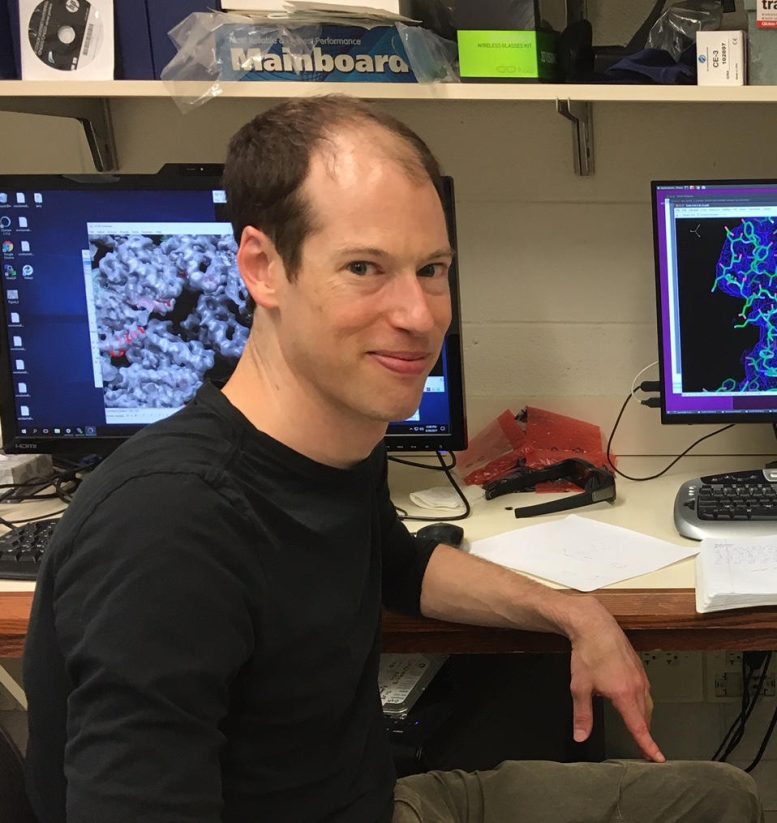New insights are enhancing scientists' efforts to stay ahead of COVID-19 and the next pandemic.
Unexpected new insights into the ways COVID-19 infects cells could shed light on the virus's adept ability to jump from one species to another and assist scientists in more accurately predicting its evolution.
The pandemic has been marked by extensive debate regarding the mechanism by which COVID-19 invades cells, largely focusing on its use of a human cell protein known as ACE2. However, recent research from the University of Virginia School of Medicine reveals that ACE2 isn't required for infection. Instead, the virus has other means it can use to infect cells.
That versatility suggests that coronaviruses can use multiple "doors" to enter cells, potentially explaining how they are so good at infecting different species.

Researcher Peter Kasson, MD, PhD, of the University of Virginia School of Medicine. Credit: UVA Health
Understanding COVID-19
COVID-19 has killed almost 7 million people around the world. Thankfully, the availability of vaccines and the increase in population immunity means that the virus is no longer the threat it once was to most people (though it remains a concern for groups such as the immunocompromised and elderly). With the expiration of the United States' official Public Health Emergency in May, most Americans have largely returned to lives similar to the ones they knew before the pandemic emerged in 2019. But COVID-19 continues to evolve and change, and scientists are keeping a close eye on it so that they can take quick action if a more dangerous variant emerges. They also continue to monitor other coronaviruses in case they jump to humans and become the next great public health threat.
As part of this effort, Kasson and his team wanted to better understand how the virus responsible for COVID-19, SARS-CoV-2, can enter human cells. Scientists have known that the virus essentially knocks on the cell's door by binding to ACE2 proteins. These proteins are bountiful on the surfaces of cells lining the nose and lungs.
SARS-CoV-2 can also bind with other proteins, however. Was it possible, the scientists wondered, that it could use those other proteins to infiltrate cells? The answer was yes. ACE-2 was the most efficient route, but it was not the only route. And that suggests that the virus can bind and infect even cells without any ACE-2 receptors at all.
That unexpected finding may help explain why coronaviruses are so adept at species-hopping, Kasson says. And that makes it even more important that scientists keep a close eye on them, he notes.
"Coronaviruses like SARS-CoV-2 have already caused one pandemic and several near misses that we know of," he said. "That suggests there are more out there, and we need to learn how they spread and what to watch out for."
Reference: "The ACE2 receptor accelerates but is not biochemically required for SARS-CoV-2 membrane fusion" by Marcos Cervantes, Tobin Hess, Giorgio G. Morbioli, Anjali Sengara and Peter M. Kasson, 5 June 2023, Chemical Science.
DOI: 10.1039/D2SC06967A
The study was funded by the Commonwealth Health Research Board, grant 207-01-18; UVA's Global Infectious Diseases Institute; and the Knut and Alice Wallenberg Foundation, grant KAW2020.0209.
News
Tiny Metal Nanodots Obliterate Cancer Cells While Largely Sparing Healthy Tissue
Scientists have developed tiny metal-oxide particles that push cancer cells past their stress limits while sparing healthy tissue. An international team led by RMIT University has developed tiny particles called nanodots, crafted from a metallic compound, [...]
Gold Nanoclusters Could Supercharge Quantum Computers
Researchers found that gold “super atoms” can behave like the atoms in top-tier quantum systems—only far easier to scale. These tiny clusters can be customized at the molecular level, offering a powerful, tunable foundation [...]
A single shot of HPV vaccine may be enough to fight cervical cancer, study finds
WASHINGTON -- A single HPV vaccination appears just as effective as two doses at preventing the viral infection that causes cervical cancer, researchers reported Wednesday. HPV, or human papillomavirus, is very common and spread [...]
New technique overcomes technological barrier in 3D brain imaging
Scientists at the Swiss Light Source SLS have succeeded in mapping a piece of brain tissue in 3D at unprecedented resolution using X-rays, non-destructively. The breakthrough overcomes a long-standing technological barrier that had limited [...]
Scientists Uncover Hidden Blood Pattern in Long COVID
Researchers found persistent microclot and NET structures in Long COVID blood that may explain long-lasting symptoms. Researchers examining Long COVID have identified a structural connection between circulating microclots and neutrophil extracellular traps (NETs). The [...]
This Cellular Trick Helps Cancer Spread, but Could Also Stop It
Groups of normal cbiells can sense far into their surroundings, helping explain cancer cell migration. Understanding this ability could lead to new ways to limit tumor spread. The tale of the princess and the [...]
New mRNA therapy targets drug-resistant pneumonia
Bacteria that multiply on surfaces are a major headache in health care when they gain a foothold on, for example, implants or in catheters. Researchers at Chalmers University of Technology in Sweden have found [...]
Current Heart Health Guidelines Are Failing To Catch a Deadly Genetic Killer
New research reveals that standard screening misses most people with a common inherited cholesterol disorder. A Mayo Clinic study reports that current genetic screening guidelines overlook most people who have familial hypercholesterolemia, an inherited disorder that [...]
Scientists Identify the Evolutionary “Purpose” of Consciousness
Summary: Researchers at Ruhr University Bochum explore why consciousness evolved and why different species developed it in distinct ways. By comparing humans with birds, they show that complex awareness may arise through different neural architectures yet [...]
Novel mRNA therapy curbs antibiotic-resistant infections in preclinical lung models
Researchers at the Icahn School of Medicine at Mount Sinai and collaborators have reported early success with a novel mRNA-based therapy designed to combat antibiotic-resistant bacteria. The findings, published in Nature Biotechnology, show that in [...]
New skin-permeable polymer delivers insulin without needles
A breakthrough zwitterionic polymer slips through the skin’s toughest barriers, carrying insulin deep into tissue and normalizing blood sugar, offering patients a painless alternative to daily injections. A recent study published in the journal Nature examines [...]
Multifunctional Nanogels: A Breakthrough in Antibacterial Strategies
Antibiotic resistance is a growing concern - from human health to crop survival. A new study successfully uses nanogels to target and almost entirely inhibit the bacteria P. Aeruginosa. Recently published in Angewandte Chemie, the study [...]
Nanoflowers rejuvenate old and damaged human cells by replacing their mitochondria
Biomedical researchers at Texas A&M University may have discovered a way to stop or even reverse the decline of cellular energy production—a finding that could have revolutionary effects across medicine. Dr. Akhilesh K. Gaharwar [...]
The Stunning New Push to Protect the Invisible 99% of Life
Scientists worldwide have joined forces to build the first-ever roadmap for conserving Earth’s vast invisible majority—microbes. Their new IUCN Specialist Group reframes conservation by elevating microbial life to the same urgency as plants and [...]
Scientists Find a Way to Help the Brain Clear Alzheimer’s Plaques Naturally
Scientists have discovered that the brain may have a built-in way to fight Alzheimer’s. By activating a protein called Sox9, researchers were able to switch on star-shaped brain cells known as astrocytes and turn them into [...]
Vision can be rebooted in adults with amblyopia, study suggests
Temporarily anesthetizing the retina briefly reverts the activity of the visual system to that observed in early development and enables growth of responses to the amblyopic eye, new research shows. In the common vision [...]





















